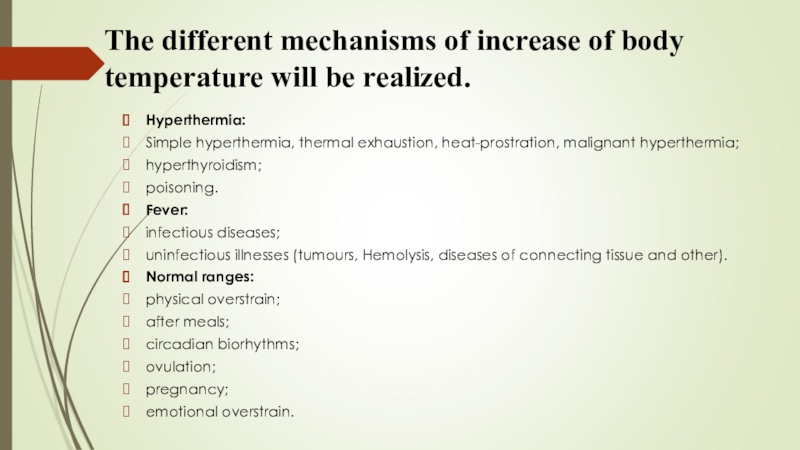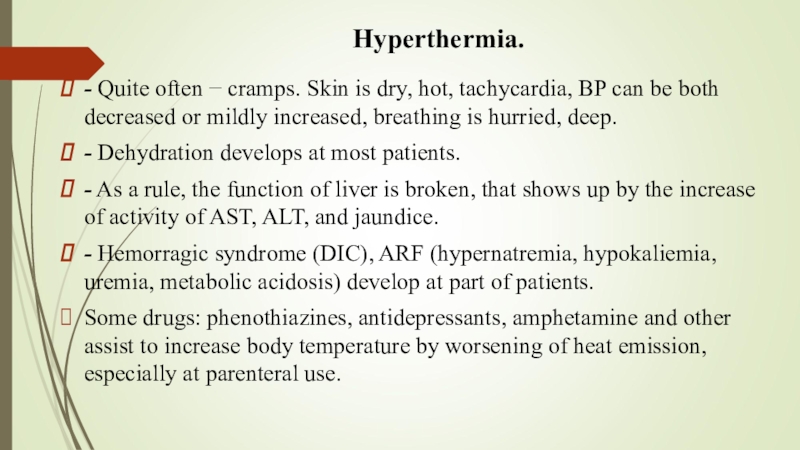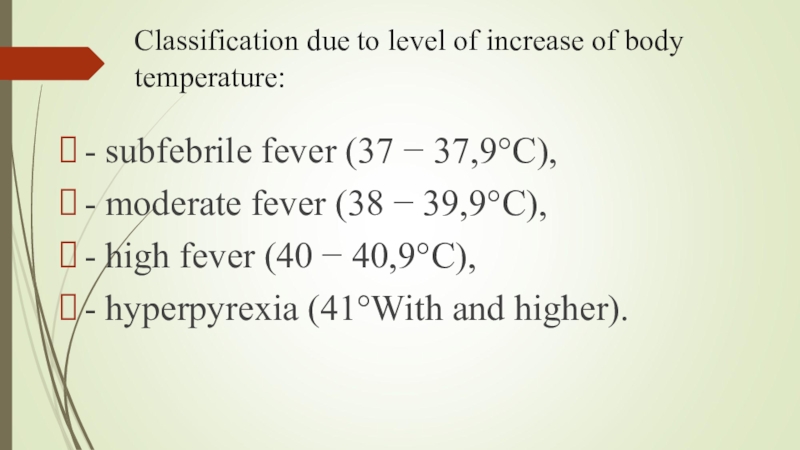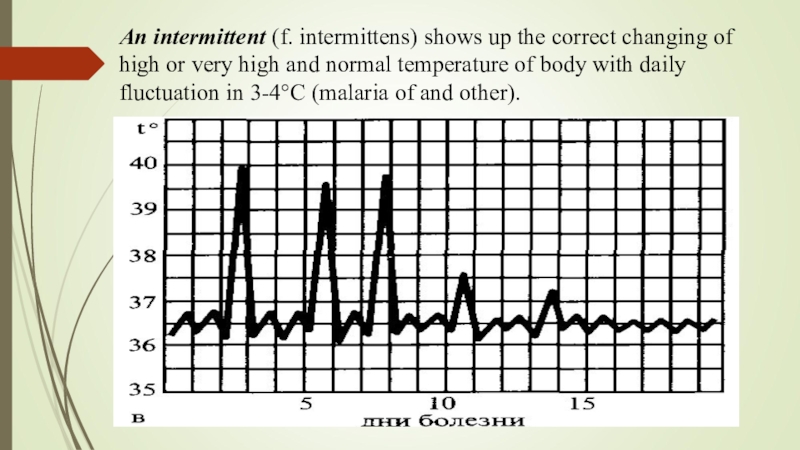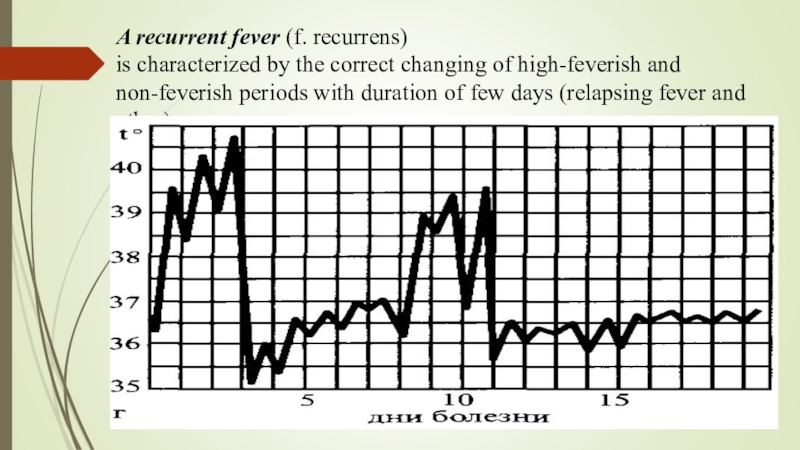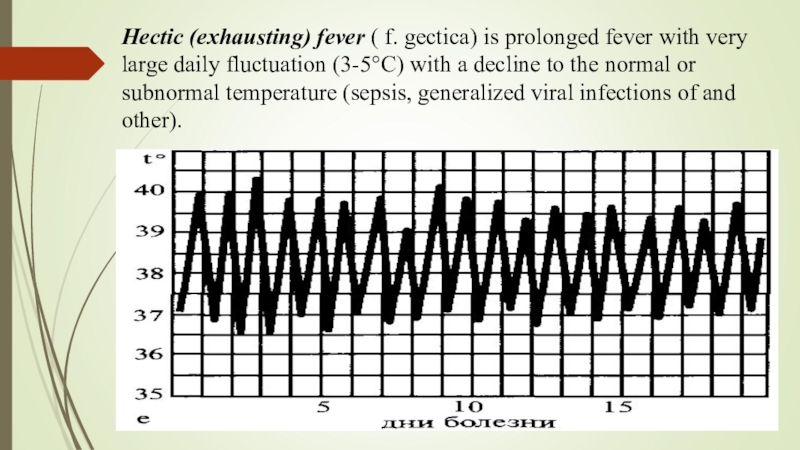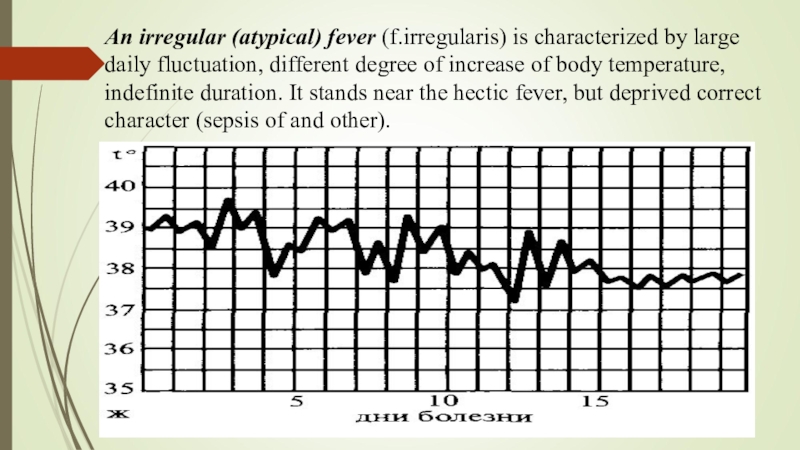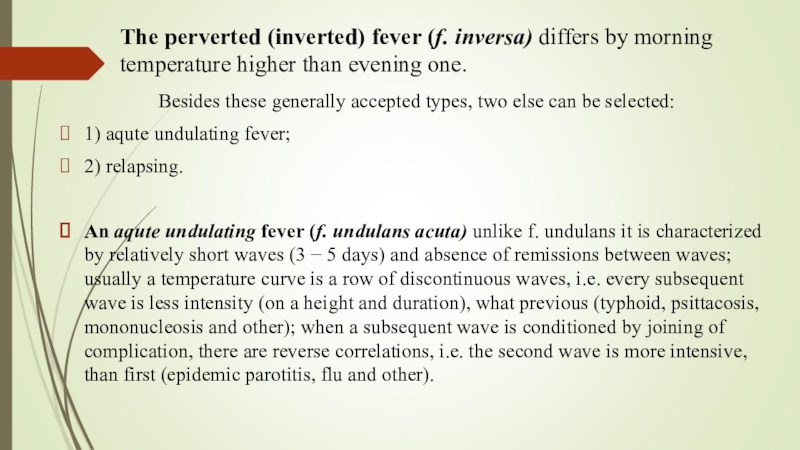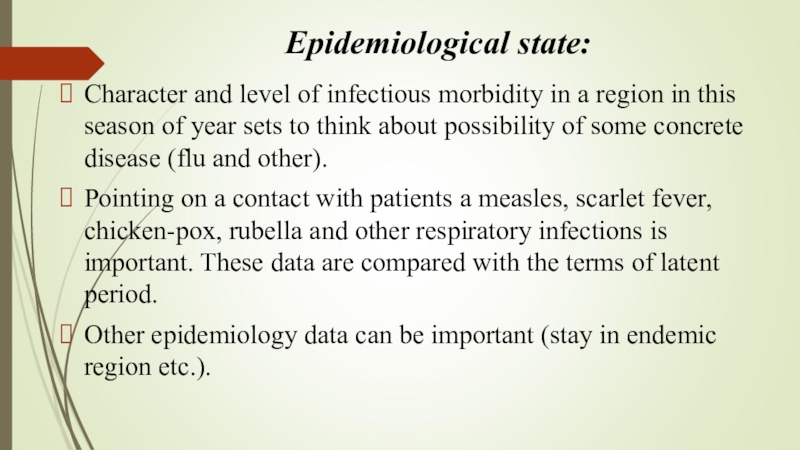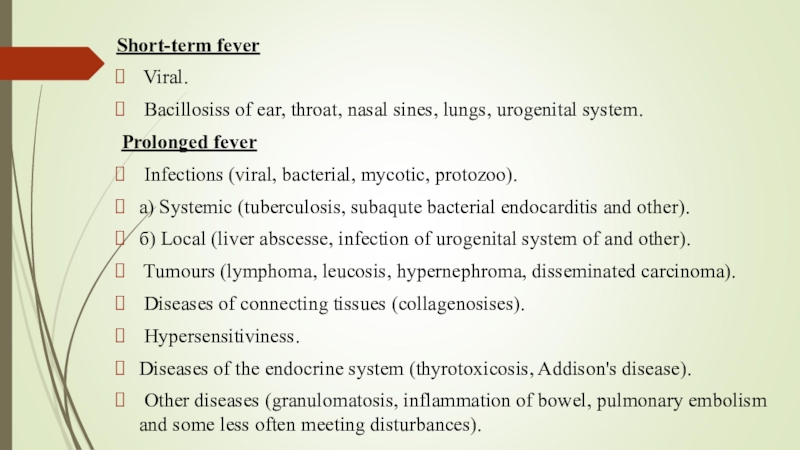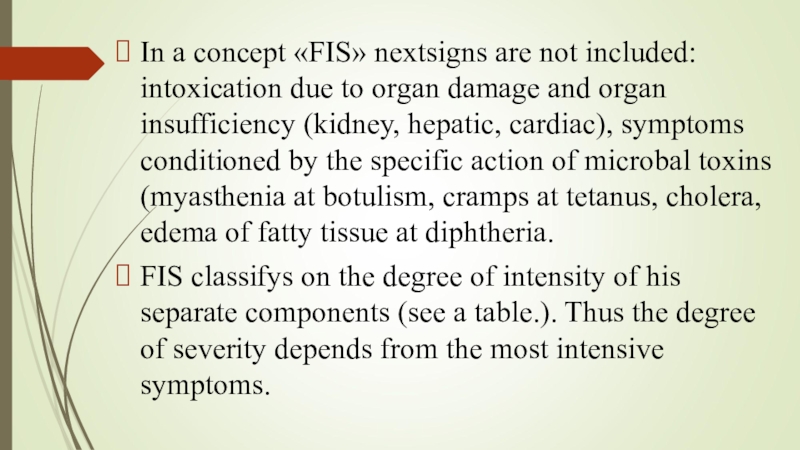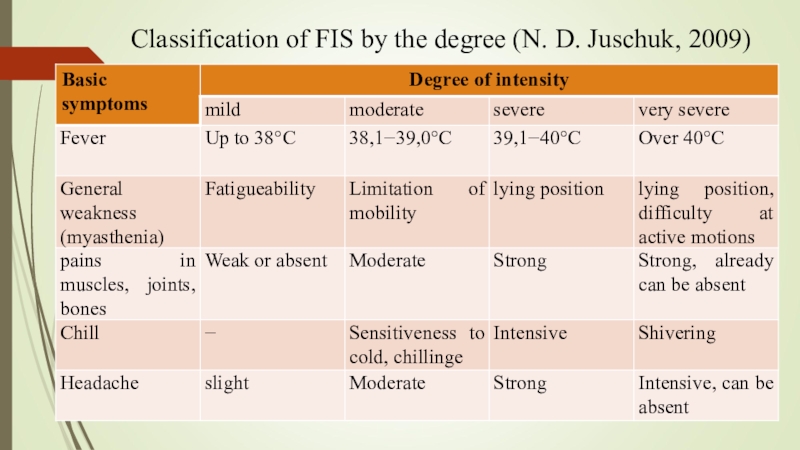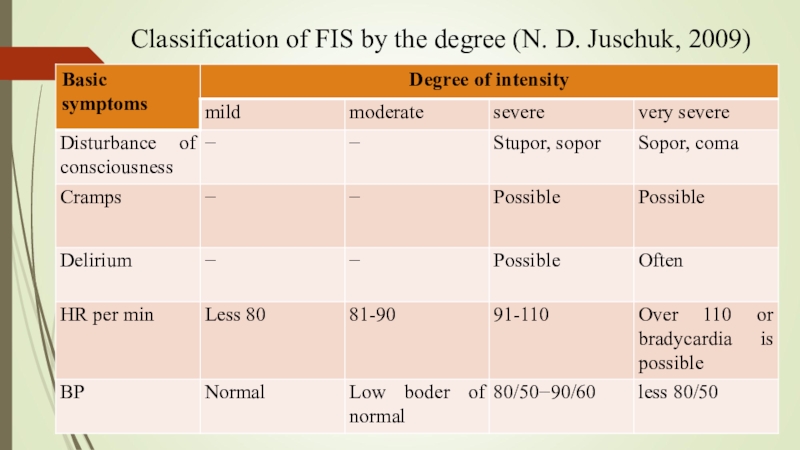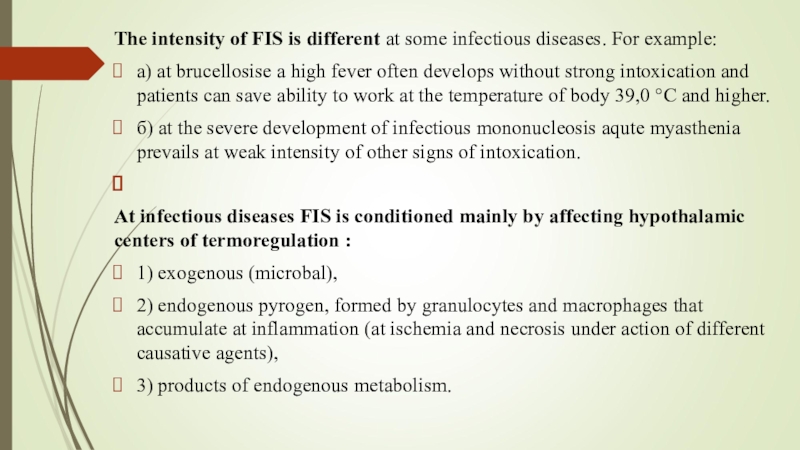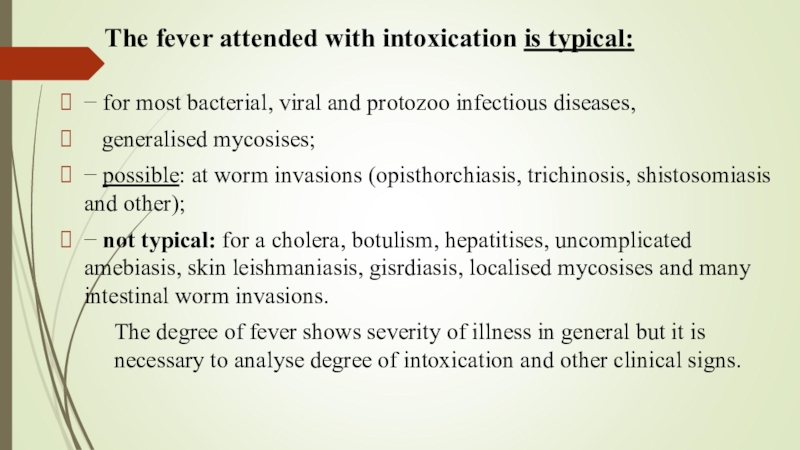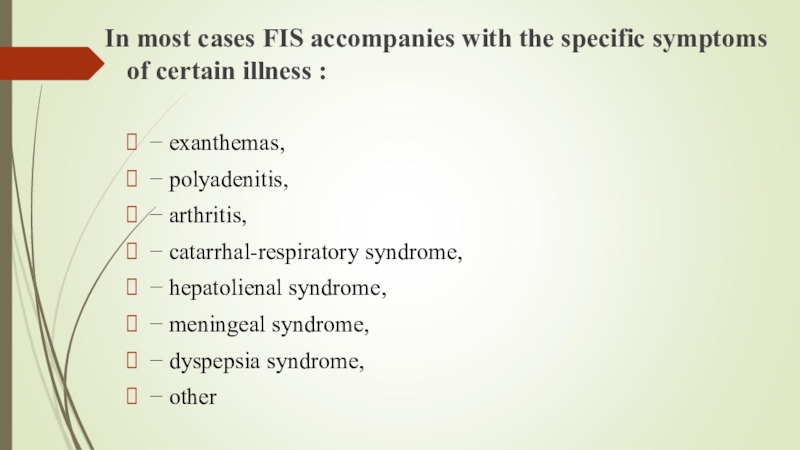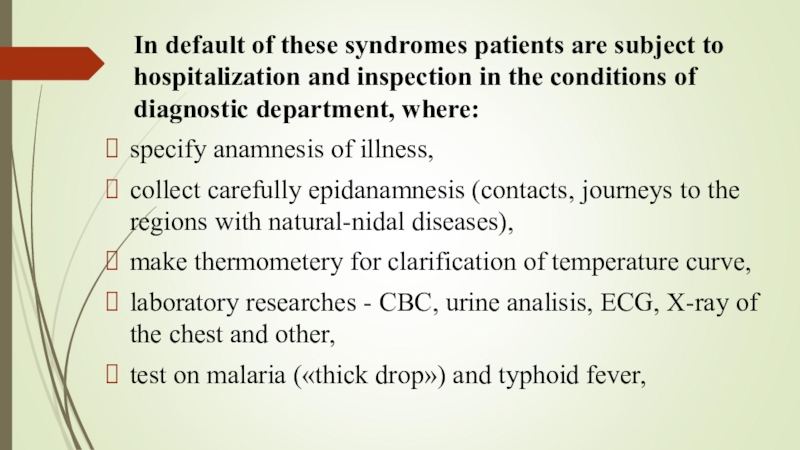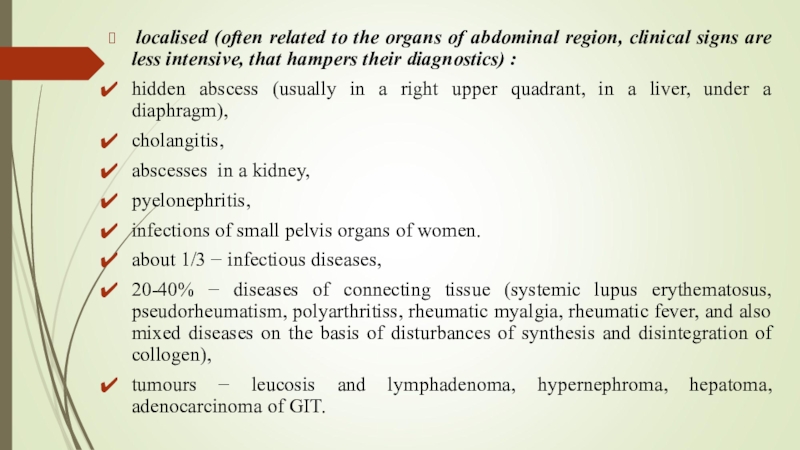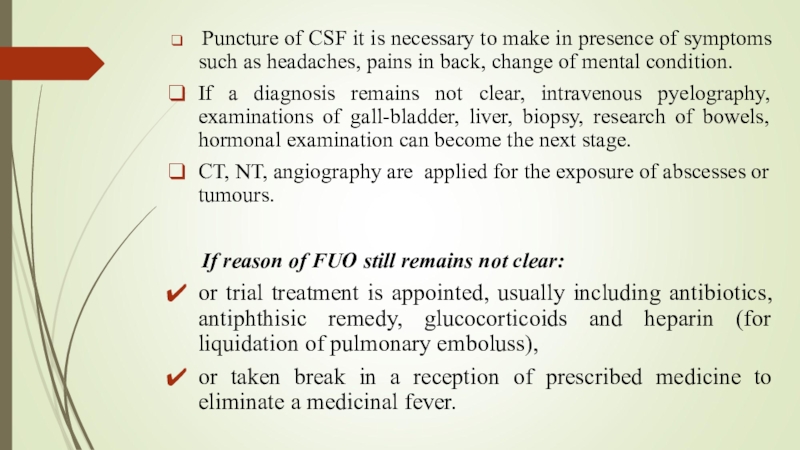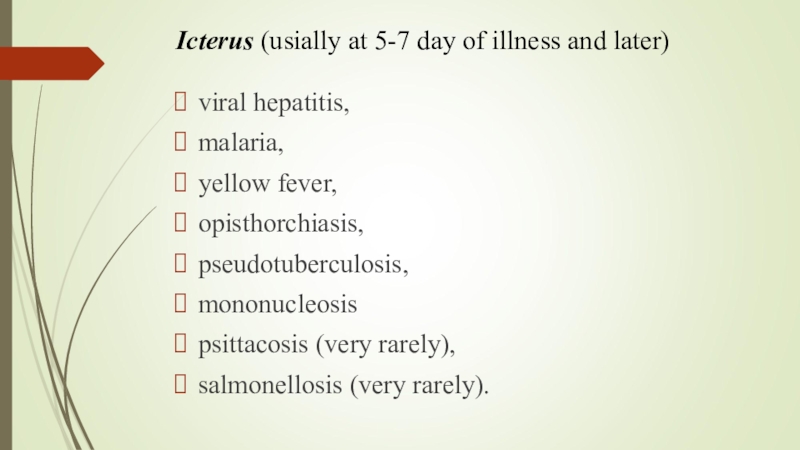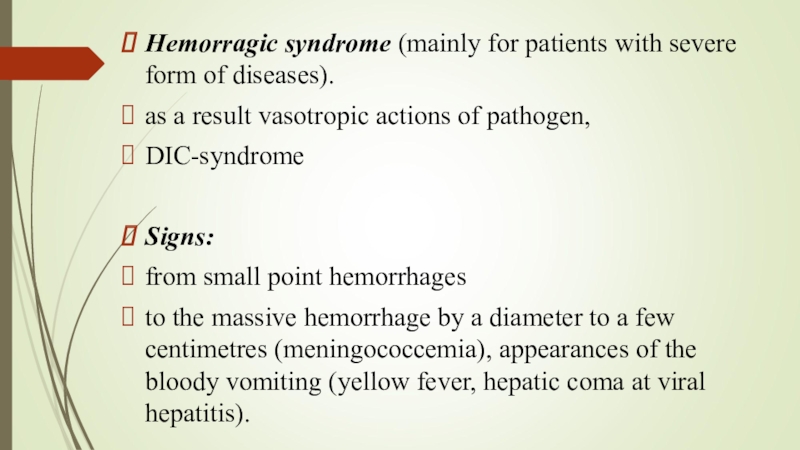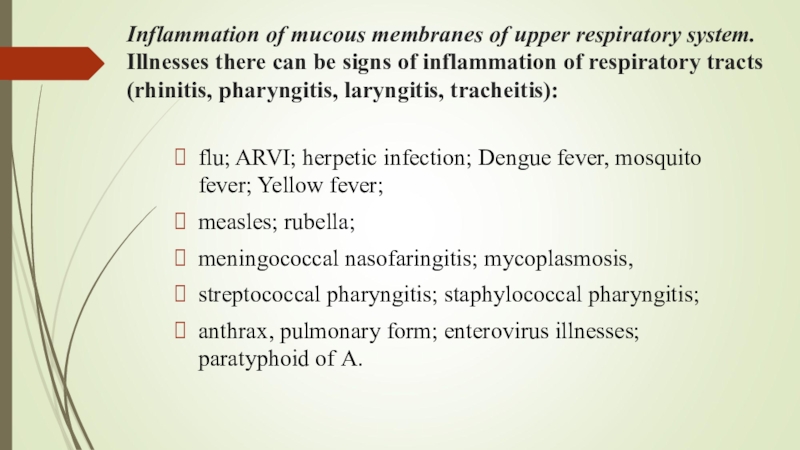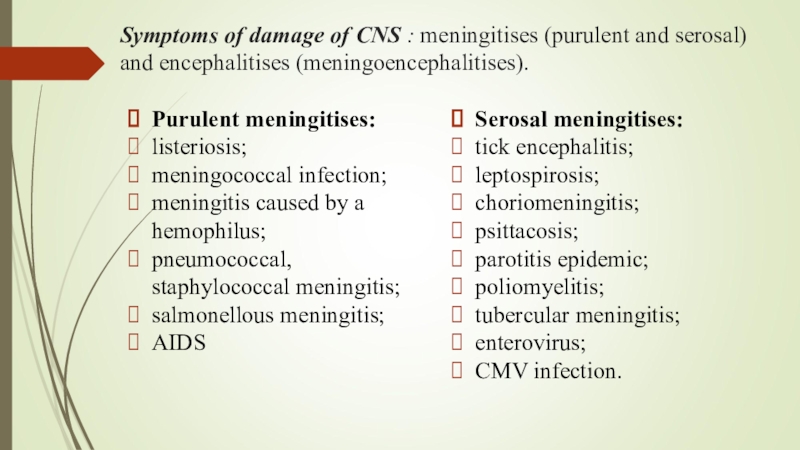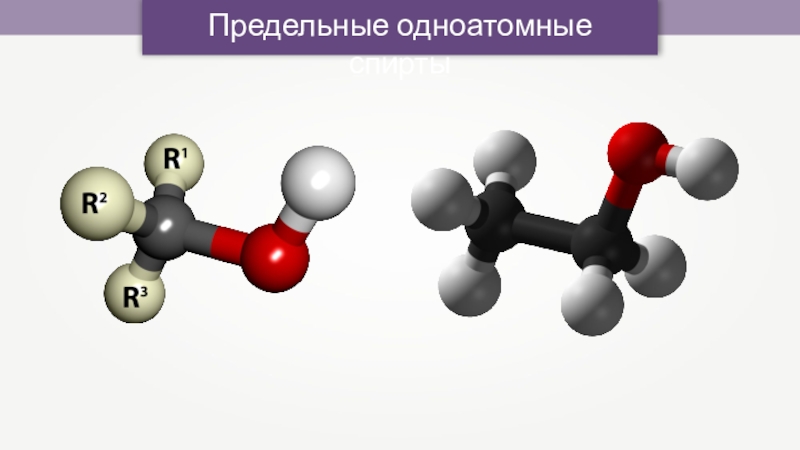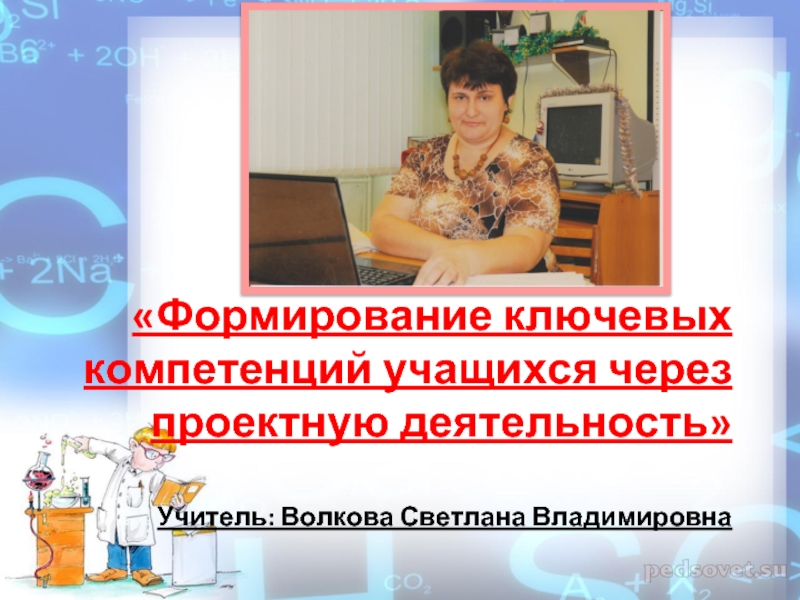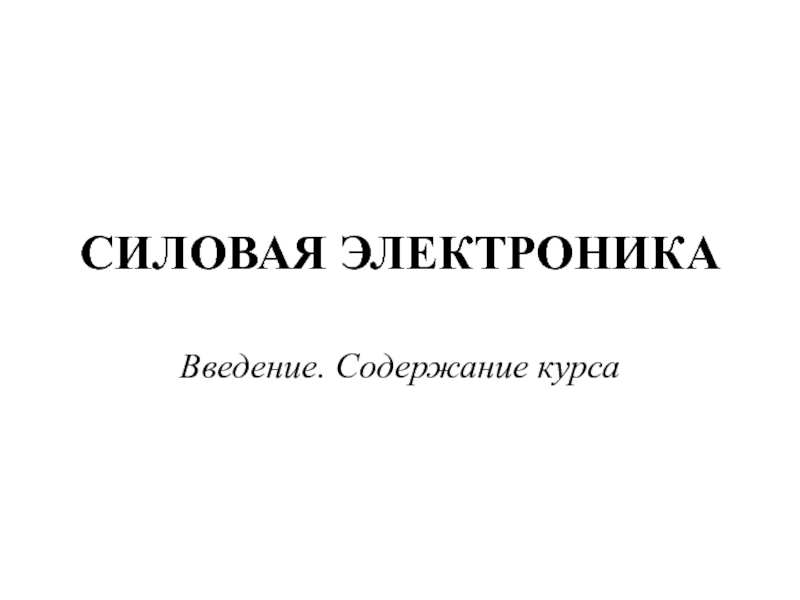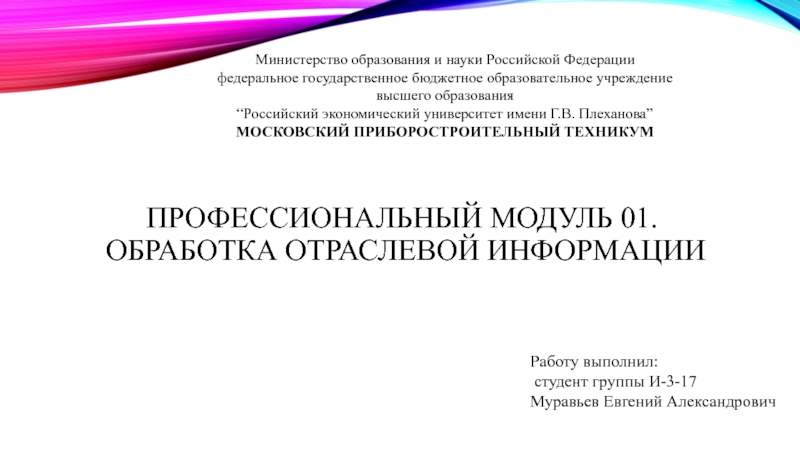Слайд 2A fever is a thermoregulatory increase of body temperature, that
is the organized and coordinated answer of organism for illness.
Increase
of body temperature is frequent and typical manifestation of many infectious diseases.
At an increase of body temperature, as a rule, an infectious disease is supposed.
However many sickly states, unconnected with infections, neoplastic processes, autoimmune and metabolic disturbances can cause a increase of body temperature.
Increase of body temperature is one of the earliest signs when other clinical signs of illness are absent that presents problems of differential-diagnostic search.
On the initial stage there are not many parameters of fever, having a diagnostic value − duration, character of temperature curve and other.
Not every increase of body temperature is a typical for infectious diseases fever.
Слайд 3An increase of body temperature can be also caused by
disbalance
between heat production and heat emission, what conduces to the
increase of body temperature. Such increase of body temperature is named hyperthermia (this term is not a synonym of fever, but sometimes meets in literature). Hyperthermia is observed at the so-called thermal diseases (heat-prostration, hyperthyroidism, poisoning by the atropine and other).
normal activity or physiological processes. A small increase of body temperature can be related to the circadian biorhythms (daily ranges). The temperature of body for a healthy man usually arrives at a maximal level to 18PM and minimum is in 3-4AM. Exactly these daily ranges increase as a result of fever. However they can be smoothed out, for example in a elderly age, at tuberculosis and also at the use of antipyretics.
Слайд 4The different mechanisms of increase of body temperature will be
realized.
Hyperthermia:
Simple hyperthermia, thermal exhaustion, heat-prostration, malignant hyperthermia;
hyperthyroidism;
poisoning.
Fever:
infectious diseases;
uninfectious illnesses
(tumours, Hemolysis, diseases of connecting tissue and other).
Normal ranges:
physical overstrain;
after meals;
circadian biorhythms;
ovulation;
pregnancy;
emotional overstrain.
Слайд 5Hyperthermia.
Simple hyperthermia during work in an apartment with the increased
temperature of air or in the sunshine can the only
increased temperature of body without some clinical signs of illness.
Thermal exhaustion has besides a moderate increase of body temperature a weakness, headache, dizziness, thirst, pallor, swoon state. A man is unable to continue work.
Heat-prostration is the most severe form of thermal disease. It is a difficult syndrome with development of thermal damage of many systems of organism, particulary CNS. The high temperature of environment prevents heat emission.
- Typical sign of heat-prostration is sharp beginning, stopping of perspiration and change of CNS from easy excitation and mental confusion up to coma.
Слайд 6Hyperthermia.
- Quite often − cramps. Skin is dry, hot, tachycardia,
BP can be both decreased or mildly increased, breathing is
hurried, deep.
- Dehydration develops at most patients.
- As a rule, the function of liver is broken, that shows up by the increase of activity of AST, ALT, and jaundice.
- Hemorragic syndrome (DIC), ARF (hypernatremia, hypokaliemia, uremia, metabolic acidosis) develop at part of patients.
Some drugs: phenothiazines, antidepressants, amphetamine and other assist to increase body temperature by worsening of heat emission, especially at parenteral use.
Слайд 7Malignant hyperthermia is rare variant of heat-prostration and is characterized
by catastrophic disorder of muscular metabolism, arising up under influence
of general anaesthesia or application of muscular relaxants (ditilin, caffeine, cardiac glycosides, general anaesthesia). It is original «farmacogenetic myopathy» conditioned genetically, that shows up only by the increase of activity of serum creatine kinase.
For children malignant hyperthermia is observed at symptoms of anomalous development : kyphosis, lordosis, short height, cryptorchidism, underdeveloped mandibula, plicate neck, ptosis.
Слайд 8Malignant hyperthermia is severe complication that appears during or soon
after anaesthesia and characterized :
By a increase of body temperature
on 1°C every 5 min, sometimes up to 43-46 °С.
Tachycardia, cyanosys, muscular rigidity, loss of consciousness.
Lethality at malignant hyperthermia arrives at 80%, almost DIC-syndrome presents.
Laboratory data show sharp increase of activity of creatine phosphokinase, LDG and AST.
Слайд 9Most difficult for differential diagnostics cases are increase of body
temperature, caused by both a fever and overburning of organism.
It can lead to development of signs of heat-prostration at infectious patient, especially at dehydration and high temperature of air (in tropical districts, anamnesis is important).
If a patient has an increased temperature of body, then the first task is a decision of question : whether a patient has really a fever or increase of body temperature appeared due to other reasons.
It is considered fever is typical for infectious diseases, however some infectious diseases (cholera, botulism) can develop without fever or at subclinical form.
Слайд 10It is established facts:
1) general and decision factor of development
of fever is production of endogenous pyrogens (IL-1, TNF, α-IFN
and other) by neutrophils, monocytes, macrophages and other tissue elements during an inflammatory process;
2) pyrogens have influence on a hypothalamus, that results in the increase of maintenance of arachidonic acid;
3) arachidonic acid, being the metabolic predecessor of prostaglandins and some other substances, increases hypothalamic termoregulation.
From all pathological reasons, caused a fever, infections are most frequent and meaningful for detection of initial diagnosis and specific treatment can be appointed whereupon.
Слайд 11 It is necessary to know some variants of reaction of
organism of patient on the damages of tissues or infection,
causing a fever. Patients in child's and juvenile period can have the expressed fever at development of infectious process.
For adults the extreme increase of temperature is observed rarely, except for the cases of heat-prostration, development of heart attack of brain or postoperative complication of malignant hyperthermia after introduction of some muscular relaxants or anesthetics.
For patients in elderly age a weak temperature reaction registers during an infectious disease, however, if a fever develops, then the state of disturbance of consciousness (disorientations) can come.
Слайд 12A differential-diagnostic value acquires not only fact of presence (or
absence) of fever, but it’s features : beginning, intensity, type
of temperature curve, terms of appearance of organ damages etc.
An increase of body temperature can be rapid (sharp), when a patient clearly marks the time of start of disease (flu, leptospirosis of and other). At a rapid increase of body temperature, as a rule, a patient marks the chill of different intensity from chilling to the shivering (malaria of and other). At some illnesses a fever grows gradually (typhoid fever).
Слайд 13Classification due to level of increase of body temperature:
- subfebrile
fever (37 − 37,9°С),
- moderate fever (38 − 39,9°С),
- high fever (40 − 40,9°С),
- hyperpyrexia (41°With and higher).
Слайд 14Classification due to length of growth of temperature to the
maximal level:
during a 1-2 days - aqute,
during a
3-5 days - subaqute,
more than 5 days - gradual.
Слайд 15A permanent fever (febris continua)
is characterized by constant high
fever, more often up to 39°C and higher, daily fluctuation
less than 1°C (observed at typhoid fever, Q-fever, spotted fever and other)
Слайд 16An aperient (remittent) fever (f. remittens)
differs by daily fluctuation
of the temperature of body over 1°C, but not more
than 2°C (psittacosis of and other).
Слайд 17An intermittent (f. intermittens) shows up the correct changing of
high or very high and normal temperature of body with
daily fluctuation in 3-4°C (malaria of and other).
Слайд 18A recurrent fever (f. recurrens)
is characterized by the correct
changing of high-feverish and non-feverish periods with duration of few
days (relapsing fever and other).
Слайд 19Undulating or wave-like fever (f. undulans) differs in gradual growth
of temperature to the high level and then it’s gradual
decline to subfebrile, and sometimes to normal; in 2-3 weeks a cycle repeats (visceral leishmaniasis, brucellosis, lymphogranulomatosis).
Слайд 20Hectic (exhausting) fever ( f. gectica) is prolonged fever with
very large daily fluctuation (3-5°С) with a decline to the
normal or subnormal temperature (sepsis, generalized viral infections of and other).
Слайд 21An irregular (atypical) fever (f.irregularis) is characterized by large daily
fluctuation, different degree of increase of body temperature, indefinite duration.
It stands near the hectic fever, but deprived correct character (sepsis of and other).
Слайд 22The perverted (inverted) fever (f. inversa) differs by morning temperature
higher than evening one.
Besides these generally accepted types, two else
can be selected:
1) aqute undulating fever;
2) relapsing.
An aqute undulating fever (f. undulans acuta) unlike f. undulans it is characterized by relatively short waves (3 − 5 days) and absence of remissions between waves; usually a temperature curve is a row of discontinuous waves, i.e. every subsequent wave is less intensity (on a height and duration), what previous (typhoid, psittacosis, mononucleosis and other); when a subsequent wave is conditioned by joining of complication, there are reverse correlations, i.e. the second wave is more intensive, than first (epidemic parotitis, flu and other).
Слайд 23A relapsing fever (f. recidiva) unlike a recurrent fever (correct
alternation of waves of fever and apyrexia) is characterized by
the relapse (usually one) of fever, that develops in different terms (from 2 days to month and more) after completion of the first temperature wave (typhoid, psittacosis, leptospirosis and other). Relapses develop at part of patients (10 − 20%). Relapse has an important diagnostic value, but its absence does not eliminate possibility of the illnesses.
Every infectious disease can have different variants of temperature curve, among that most frequent, typical for one or another nosology form presents. Sometimes it even allow to put diagnosis (three-day malaria of and other).
Слайд 24For differential diagnostics next is important:
- height and duration of
fever;
- interval between start of fever and appearance of organ
damages;
- epidemiological state;
- change of temperature curve under influence of etiotropic curative remedy.
Слайд 25Duration:
- A short increase of body temperature already allows to
suspect such often meeting illnesses as herpangina, ARVI, aqute shigellosis,
flu, quinsy without complications and other.
- The prolonged increase of body temperature (over month) is observed relatively rarely and only at some infectious diseases with prolonged or chronic development (brucellosis, toxoplasmosis, visceral leishmaniasis, tuberculosis and other).
Слайд 26Interval between start of fever and appearance of organ damages:
At
some infectious diseases this period is less than 24h (herpetic
infection, scarlet fever, rubella, meningococcemia and other), at other it lasts from 1 to 3 days (measles, chicken-pox), and finally at the some illnesses he is over 3 days (typhoid fever, viral hepatitis and other).
Слайд 27Epidemiological state:
Character and level of infectious morbidity in a region
in this season of year sets to think about possibility
of some concrete disease (flu and other).
Pointing on a contact with patients a measles, scarlet fever, chicken-pox, rubella and other respiratory infections is important. These data are compared with the terms of latent period.
Other epidemiology data can be important (stay in endemic region etc.).
Слайд 28For differential diagnostics the change of temperature curve under influence
of etiotropic curative remedy on the ambulatory stage or as
a result of self-treatment is significant (viral, bacterial or other etiology). It is necessary to confess that it does not always allow to suppose the presence of certain diseases.
Слайд 29Short-term fever
Viral.
Bacillosiss of ear, throat, nasal sines, lungs,
urogenital system.
Prolonged fever
Infections (viral, bacterial, mycotic, protozoo).
а) Systemic
(tuberculosis, subaqute bacterial endocarditis and other).
б) Local (liver abscesse, infection of urogenital system of and other).
Tumours (lymphoma, leucosis, hypernephroma, disseminated carcinoma).
Diseases of connecting tissues (collagenosises).
Hypersensitiviness.
Diseases of the endocrine system (thyrotoxicosis, Addison's disease).
Other diseases (granulomatosis, inflammation of bowel, pulmonary embolism and some less often meeting disturbances).
Слайд 30 Fever Conditioned by a stay in a hospital
Patients
without complications.
а) Postoperative infection.
б) drug disease.
в) Complications of the respiratory
system (atelectasis, embols, pneumonia).
г) Infections of urination system.
д) Phlebitis.
е) Inadequate drainage of tissue liquid.
Patients with a secondary immunodeficiency.
а) same reasons of fevers what for patients without complications.
б) Infections caused by opportunistic microorganisms.
в) Fever related to the tumours.
Слайд 31At the infectious diseases with a fever an important concept
is Feverish-intoxication syndrome (FIS) − syndrome characterized by nonspecific adaptation
reaction of macroorganism on microbal aggression. Degree of intensity of FIS − universal criterion of estimation of severity of development of infectious process.
In a concept «Feverish-intoxication syndrome» is included:
- fever,
- myasthenia,
- symptoms of damage of CNS and cardiovascular system.
Слайд 32In a concept «FIS» nextsigns are not included: intoxication due
to organ damage and organ insufficiency (kidney, hepatic, cardiac), symptoms
conditioned by the specific action of microbal toxins (myasthenia at botulism, cramps at tetanus, cholera, edema of fatty tissue at diphtheria.
FIS classifys on the degree of intensity of his separate components (see a table.). Thus the degree of severity depends from the most intensive symptoms.
Слайд 33Classification of FIS by the degree (N. D. Juschuk, 2009)
Слайд 34Classification of FIS by the degree (N. D. Juschuk, 2009)
Слайд 35Classification of FIS by the degree (N. D. Juschuk, 2009)
Слайд 36- The presented classification allows to estimate severity of the
state of patient, but does not eliminate variants when the
state of patient is not corresponded to it.
- If patient’s criteria corresponding to the mild degree of intoxication, but disturbance of consciousness or hypotonia present, intoxication and state of patient is necessary to detect as severe.
- If the separate criteria of intoxication are not adequit to other, it is necessary to eliminate organ pathology, for example:
а) headache with nausea and vomiting, disorders of consciousness, cramps allow to think of neuroinfection
б) tachycardia, hypotonia − about the damage of heart,
в) nausea, vomiting, anorexia − about a damage GIT,
г) high fever at the mild degree of intoxication requires the exception of noninfectious etiology of illness.
Слайд 37The intensity of FIS is different at some infectious diseases.
For example:
а) at brucellosisе a high fever often develops without
strong intoxication and patients can save ability to work at the temperature of body 39,0 °C and higher.
б) at the severe development of infectious mononucleosis aqute myasthenia prevails at weak intensity of other signs of intoxication.
At infectious diseases FIS is conditioned mainly by affecting hypothalamic centers of termoregulation :
1) exogenous (microbal),
2) endogenous pyrogen, formed by granulocytes and macrophages that accumulate at inflammation (at ischemia and necrosis under action of different causative agents),
3) products of endogenous metabolism.
Слайд 38So, during realization of differential diagnostics of infectious diseases with
fever it is necessary to analyse next parameters:
Height of fever.
Duration
of fever.
Type of temperature curve.
Duration of period from the start of fever to appearance of typical organ damage.
Character of damages of organs.
Epidemiology
Influence of etiotropic remedy on the fever.
Слайд 39The fever attended with intoxication is typical:
− for most bacterial,
viral and protozoo infectious diseases,
generalised mycosises;
− possible:
at worm invasions (opisthorchiasis, trichinosis, shistosomiasis and other);
− not typical: for a cholera, botulism, hepatitises, uncomplicated amebiasis, skin leishmaniasis, gisrdiasis, localised mycosises and many intestinal worm invasions.
The degree of fever shows severity of illness in general but it is necessary to analyse degree of intoxication and other clinical signs.
Слайд 40In most cases FIS accompanies with the specific symptoms of
certain illness :
− exanthemas,
− polyadenitis,
− arthritis,
− catarrhal-respiratory syndrome,
− hepatolienal syndrome,
−
meningeal syndrome,
− dyspepsia syndrome,
− other
Слайд 41In default of these syndromes patients are subject to hospitalization
and inspection in the conditions of diagnostic department, where:
specify anamnesis
of illness,
collect carefully epidanamnesis (contacts, journeys to the regions with natural-nidal diseases),
make thermometery for clarification of temperature curve,
laboratory researches - CBC, urine analisis, ECG, X-ray of the chest and other,
test on malaria («thick drop») and typhoid fever,
Слайд 42More deep research includes researches directed to the exception of
−
pathologies of ENT-organs;
− tuberculosis (consultation of phthisiologist, Mantoux tuberculin test);
−
sepsis (repeated bacteriological research of blood, urine);
− endocarditis (USG of heart),
− pathologies of abdominal region, pelvis, kidneys;
− collagenosess (rheumatological tests, LE- cells);
− oncology (albumen, albuminous factions, oncomarkers, sternal puncture,
X-ray of flat bones, consultation of haematologist);
− central disturbance of termoregulation (EEG, NT, consultation of neurologist);
− hyperthyroidism (hormones of thyroid, USG, consultation of endocrinologist).
Слайд 43Before determination of clinical diagnosis pathogenetic treatment directed to the
detoxication and decline of excessive temperature reaction is used.
At the
mild degree of severity :
domestic regime,
diet: drink to 3 l/day. (tea, juices, fruit drink, fruit compote, water), exception of spices, fried and caned food.
At middle severity:
bed rest, hospitalization on individual indication (fever 5 days and more, severe chronic diseases),
same diet with the exception of fats
antipyretics (NSAD).
Слайд 44At a severe and very severe degree:
hospitalization, strong bed regime
diet:
mechanically and chemically sparing diet with limitation of fats and
albumen,
antipyretics according to general and individual contra-indications, physical cooling methods,
i.v. detoxication, according to indication albumen, plasma.
Antimicrobial remedy are not indicated at home before determination of diagnosis; at hospital - after the bacteriologicexamination; at suspicion on severe infection wide spectrum antibiotics are indicated i.v.
GLUCOCORTICOIDS (prednisolon and other) are used only on individual indication on a background antimicrobial therapy.
Слайд 45Fevers at out-patients
Short-term fevers (duration less one week) usually viral
and finishs by spontaneous recovery.
Most widespread reasons of short-term
fever of unviral nature of − it is bacillosiss of ENT-organs, bronchi or urogenital system at the normal immune system.
If patient has increased temperature more than 1-2 weeks without a diagnosis, this “fever of unknown origin” (FUO) needs more careful examination.
Слайд 46For comfortable analysis of clinical data at FUO all infectious
diseases are divided into:
systemic:
tuberculosis(usually miliary);
subaqute bacterial endocarditis,
brucellosis,
toxoplasmosis,
chronic meningococcemia (rarely),
salmonellosis,
CMV-INFECTION,
EBV-INFECTION
Слайд 47 localised (often related to the organs of abdominal region,
clinical signs are less intensive, that hampers their diagnostics) :
hidden
abscess (usually in a right upper quadrant, in a liver, under a diaphragm),
cholangitis,
abscesses in a kidney,
pyelonephritis,
infections of small pelvis organs of women.
about 1/3 − infectious diseases,
20-40% − diseases of connecting tissue (systemic lupus erythematosus, pseudorheumatism, polyarthritiss, rheumatic myalgia, rheumatic fever, and also mixed diseases on the basis of disturbances of synthesis and disintegration of collogen),
tumours − leucosis and lymphadenoma, hypernephroma, hepatoma, adenocarcinoma of GIT.
Слайд 48 noninfectious reasons of FUO include reasons not considered before
:
pulmonary embolism,
Besnier-Boeck-Schaumann (sarcoidosis)
relapsing cellulitis (illness of Вебера-Крисчена),
medicinal fever,
domestic Mediterranean fever,
periodic fever,
hyperthyroidism,
Addison's disease,
nonspecific granulomatosis of liver.
Слайд 49 The initial laboratory examination of patient with FUO must
include:
CBC with the count of formula of blood, ESR;
serum test
on a syphilis;
X-ray of thorax;
tests of the functional state of liver;
uranalysiss and stool on the presence of the hidden blood;
microbiological research of urine, stool, and also from three to six researchs of blood (with the exposure of mushrooms of sort of Candida and Trichophyton);
USG of organs of abdominal region and pelvis;
Tuberculin test;
complex of indexes of autoimmune diseases (antinuclear antibodies, rheumatoid factor and other);
Слайд 50 Puncture of CSF it is necessary to make in
presence of symptoms such as headaches, pains in back, change
of mental condition.
If a diagnosis remains not clear, intravenous pyelography, examinations of gall-bladder, liver, biopsy, research of bowels, hormonal examination can become the next stage.
CT, NT, angiography are applied for the exposure of abscesses or tumours.
If reason of FUO still remains not clear:
or trial treatment is appointed, usually including antibiotics, antiphthisic remedy, glucocorticoids and heparin (for liquidation of pulmonary emboluss),
or taken break in a reception of prescribed medicine to eliminate a medicinal fever.
Слайд 51Fevers for inhospital patients
Next reasons of its origin are assumed:
postoperative
complications (abscess);
medicinal fever (disturbance of intercommunication of pulse and temperature,
eosinophilia, atypical lymphocytosis and rash, although often − only fever in default of the enumerated signs);
complications related to the respiratory system (pneumonia, atelectasis and embolism);
infections of urinoexcretory tract;
phlebitises, especially around the places of intravenous injection;
inadequate drainage of the tissue liquids infected or sterile (for example, pleural liquid).
Increase of temperature on 0,5-1°C sometimes is possible at the hospitalized patients − "psychogenic fever".
Слайд 52For the hospitalized patient with the signs of the secondary
immunodeficiency conditioned by either a basic disease (for example, presence
of tumour) or use of antibiotics or immunodepressants, it is necessary to expose infectious diseases caused mainly by:
ordinary hospital microflora,
Candida,
Aspergillus,
Phycomycetes,(Pneumocystis carimi − analysis of sputum not always sufficient for diagnostics, − research of biopsy material is needed at a bronchoscopy)
Pneumocystis,
Toxoplasma,
Listeria, Legionella,
Nocardia,
CMV and EBV
Слайд 53In the aqute phase of disease trial course of treatment
by antibiotics is possible before result of the microbiological research.
It is directed against the most credible for localization causative agents (for example, streptococci, anaerobic microorganisms and Gram-negative enterobacteria for GIT or enterococci and gram-negative bacteria in case of urogenital sepsis).
It is important to remember that for some patients with sepsis, especially in elderly age a leucocytosis and fever can be absent but present nonspecific signs:
hypotension,
hypothermia,
hypoglycemia,
oliguria,
confusion of consciousness.
Слайд 54From organ damages those that is more typical for infectious
diseases have the special differentially-diagnostic value:
1) exanthema;
2) enanthema;
3)
hyperemia of face and neck;
4) icterus;
5) hemorragic syndrome;
6) inflammation of mucous membranes of upper respiratory tracts;
7) pneumonia;
8) tonsillitis;
9) diarrea;
10) increase of liver and spleen;
11) lymphadenopathy;
12) changes of CNS (meningitises and encephalitises).
Слайд 55Infectious diseases with enanthema:
herpangina;
herpetic infection;
candidiasis of mucous membranes;
measles;
zoster;
chikenpox;
smallpox;
parotitis epidemic;
Stevens-Johnson syndrome;
epidemic
typhus.
Слайд 56The hyperemia of face and neck («hood sign») usually combines
with the injection of vessels of conjunctiva, sclera and moderate
hyperemia of mucous membrane of pharynx :
Brill disease;
flu;
Denge fever, Yellow fever, Marburg fever and other hemorragic fevers
Rikketsiosises;
Tsutsugamushi;
leptospirosis;
pseudotuberculosis.
Слайд 57Icterus (usially at 5-7 day of illness and later)
viral hepatitis,
malaria,
yellow fever,
opisthorchiasis,
pseudotuberculosis,
mononucleosis
psittacosis (very rarely),
salmonellosis (very rarely).
Слайд 58Hemorragic syndrome (mainly for patients with severe form of diseases).
as a result vasotropic actions of pathogen,
DIC-syndrome
Signs:
from small point
hemorrhages
to the massive hemorrhage by a diameter to a few centimetres (meningococcemia), appearances of the bloody vomiting (yellow fever, hepatic coma at viral hepatitis).
Слайд 59Inflammation of mucous membranes of upper respiratory system.
Illnesses there
can be signs of inflammation of respiratory tracts (rhinitis, pharyngitis,
laryngitis, tracheitis):
flu; ARVI; herpetic infection; Dengue fever, mosquito fever; Yellow fever;
measles; rubella;
meningococcal nasofaringitis; mycoplasmosis,
streptococcal pharyngitis; staphylococcal pharyngitis;
anthrax, pulmonary form; enterovirus illnesses; paratyphoid of А.
Слайд 60Tonsillitis:
quinsies (streptococcal, staphylococcal, necrotic);
adenoviral diseases;
anginal-bubonic form of rabbit-fever;
typhoid fever;
diphtheria of
pharynx;
infectious mononucleosis;
candidiasis;
scarlet fever.
Слайд 61Tonsillitis at noninfectious illnesses::
syphilis,
radiation illness,
leucosises,
agranulocytosis of and
other
Слайд 62Increase of liver and spleen («hepatolienal syndrome»), at infectious diseases
more often the increase of both organs is marked usially
only after 4-7 days from the start of illness.
Rikketsiosises;
brucellosis;
viral hepatitis;
yellow fever;
pseudotuberculosis;
leishmaniasis;
malaria;
typhoid fever;
salmonellosis;
sepsis;
typhus recurrent;
rabbit-fever;
mononucleosis;
infectious erythema.
Слайд 63Lymphadenopathy
The increase of lymphatic nodes in combination with a fever
can be observed at noninfectious illnesses (lymphogranulomatosis, metastases of tumours,
illness of blood of and other), but however such combination more often testifies to the infectious process and has a substantial value for differential diagnostics of fevers.
It is expedient to subdivide the increase of lymphatic nodes into the following 3 subgroups: buboes (considerable increase regional to the gate of infection lymphatic nodes), generalised lymphadenopathy and mesadenitises.
Слайд 64Forming of buboes :
felinosis;
rat-bite fever;
rabbit-fever;
plague.
Presence of mesadenitis:
yersiniosis;
pseudotuberculosis;
typhoid fever;
toxoplasmosis;
tuberculosis.
Generalised lymphadenopathy:
adenoviral infection;
brucellosis;
measles;
rubella;
mononucleosis
infectious;
parainfluenza;
sepsis;
HIV/AIDS;
toxoplasmosis.
Слайд 65Symptoms of damage of CNS : meningitises (purulent and serosal)
and encephalitises (meningoencephalitises).
Purulent meningitises:
listeriosis;
meningococcal infection;
meningitis caused by a hemophilus;
pneumococcal,
staphylococcal meningitis;
salmonellous meningitis;
AIDS
Serosal meningitises:
tick encephalitis;
leptospirosis;
choriomeningitis;
psittacosis;
parotitis epidemic;
poliomyelitis;
tubercular meningitis;
enterovirus;
CMV infection.
Слайд 66Subdividing of meningitises into purulent and serosal is possible only
after Lumbal puncture that is usually produced after detection of
syndrome of meningitis.
Encephalitises (meningoencephalitises) :
Venezuelan encephalomyelitis of horse;
eastern encephalomyelitis of horse;
hemorragic fever Omsk;
herpetic infection;
influenzal encephalopathy;
western encephalomyelitis of horse,
tickborn, Californian, Japanese encephalitis;
whooping-cough;
chikenpox;
smallpox;
parotitis epidemic;
poliomyelitis;
AIDS;
epidemic typhus;
toxoplasmosis;
CMV-INFECTION;
enteroviral encephalitis.
measles;
rubella;
Слайд 67Epidemiologcal data.
1) staying in tropical countries or in the
endemic regions;
2) season;
3) hemotransfusion according to duration of
latent period;
4) contact with sick respiratory infections;
5) zoonotic illnesses (contact with a cattle, sheep, dogs, cats, rodents, birds).



